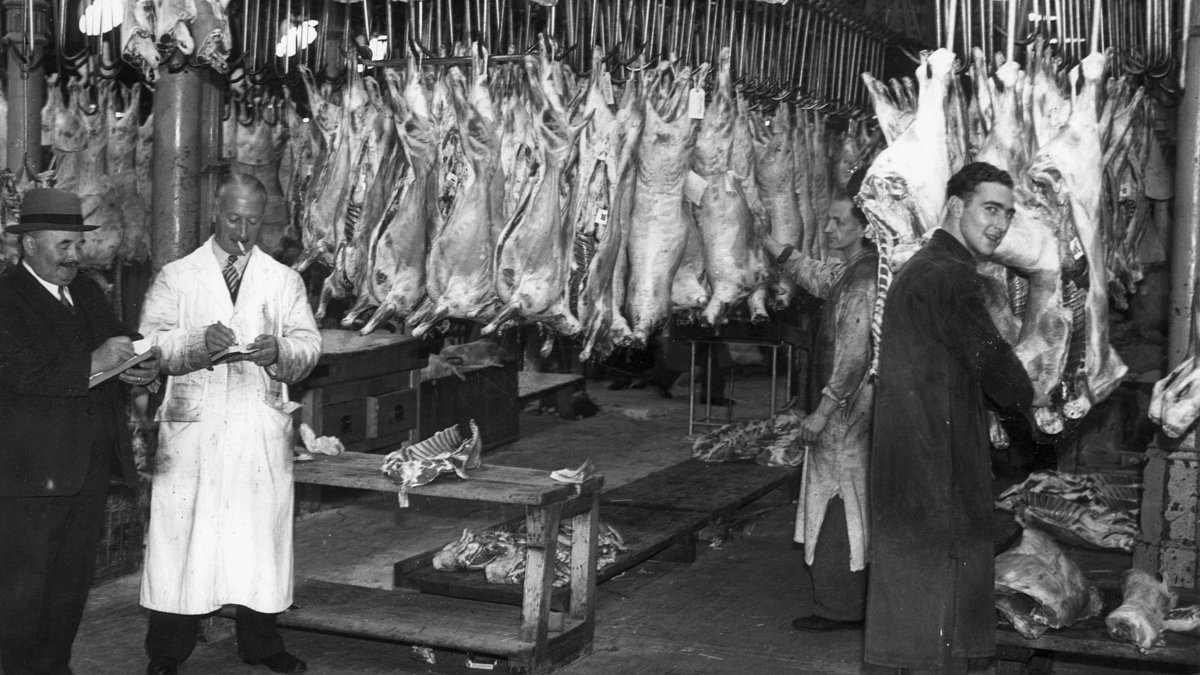For centuries, the execution of the damned and the slaughter and sale of animals went on side by side.
Just a few hundred feet separated the site where Scottish leader William Wallace – and many more besides him – was horrifically put to death and what is now Smithfield Market in central London.
It was, wrote Charles Dickens in Oliver Twist, a place where ‘filth and mire’ rose ‘nearly ankle-deep’, as the ‘reeking bodies of cattle’ massed all around.
Another Victorian writer branded it a hub of ‘cruelty, filth, effluvia, pestilence, impiety, horrid language, danger, disgusting and shuddering sights, and every obnoxious item that can be imagined.’
But now that it has been announced that the capital’s oldest meat market is to close – 900 years since trading began at Smithfield – a new, less bloody future beckons.
In 1174, Smithfield was described by William Fitzstephen, clerk to Thomas Becket, as ‘a smooth field where every Friday there is a celebrated rendezvous of fine horses to be sold, and in another quarter are placed vendibles of the peasant, swine with their deep flanks, and cows and oxen of immense bulk.’
Under King Edward III in 1327, the City of London Corporation was given the right to run it and other wholesale food markets.
But from the early 13th century, Smithfield was also used as an execution site.
Wallace – whose death was famously depicted in Mel Gibson’s film Braveheart – was hanged, drawn and quartered there in 1305 after being dragged naked through the streets.
In 1381, Wat Tyler, the leader of the failed Peasants’ Revolt, was beheaded at Smithfield.
And, in 1546 during the reign of King Henry VIII, Protestant preacher Anne Askew was burnt at the stake at Smithfield as a huge crowd of people looked on.
She was just one of dozens of people burned in the same place throughout the Tudor period.
The market and the surrounding area would go on to emerge unscathed from the 1666 Great Fire of London, which devastated much of the rest of the capital.
In 1945, as the Second World War neared its conclusion, a German V2 rocket that struck nearby caused an explosion which tore through the market buildings and caused more than 100 deaths.
And in 1958, two firefighters were killed tackling a blaze that broke out in a cold storage firm’s premises in the market.
The fire burned for three days and is regarded as one of the worst in London since the Blitz in 1940.
Smithfield Market has received several royal visitors. In 1926, the future King Edward VIII spent 90 minutes inspecting stalls.
Nearly 80 years later, in 1980, King Charles enjoyed himself at the market.
The then Prince of Wales was cheered and clapped as he tested the weight of a barrow laden with meat.
The Queen Mother made several visits to the market, including for the current set-up’s centenary in 1968 and in 1997.
The current market site was built in 1868, designed by architect Sir Horace Jones.
By then, the site had shifted from being a livestock hub to a wholesale meat market, as traders sought to accommodate the appetite of London’s booming population.
Jones, who had designed Tower Bridge, developed a complex of sophisticated buildings. Among them was the Central Meat Market, the General Market and the Poultry Market.
One of the most revolutionary features of the site was the railway that ran underneath the site, bringing the freight trains laden with supplies of meat.
The market would be open at night, so that traders had time to prepare their meat for sale a few hours later.
However, from 1945 onwards, Smithfield became less busy as supermarkets began buying directly from suppliers.
But Smithfield remains one of London’s three main markets that remains at its original location in the heart of the City.
Billingsgate fish market moved from Lower Thames Street to Poplar, East London, in 1982, while Spitalfields fruit and veg market relocated to Leyton, East London, in 1991.
But the City of London Corporation said its council yesterday voted to cease trading.
There had been bold plans to relocate the market and Billingsgate to a new £1 billion development in Dagenham.
But the corporation put the relocation plans on hold earlier this month and confirmed at a private Court of Common Council meeting on Tuesday that it has formally ended its interest in relocating the two sites.
It said it will now provide financial compensation to traders at the markets, reported to be worth more than £300 million.
Traders will be able to continue their operations at the markets until at least 2028, the corporation added.
